Abstract
The complete amino acid sequence for the type I isozyme of hexokinase from rat brain has been deduced from the nucleotide sequence of cloned cDNA. The nucleotide sequence of 91 bases in the 5' untranslated region as well as that of the entire 3' untranslated region preceding the poly(A) sequence have also been determined. The N- and C-terminal halves of brain hexokinase show extensive sequence similarity to each other and to yeast hexokinase. These results provide direct support for the proposal that the mammalian hexokinases of approximately 100 kDa have evolved by a process of duplication and fusion of a gene encoding an ancestral hexokinase similar to the yeast enzyme of approximately 50 kDa. Taking this similarity in sequence to indicate basic similarity in structure between the N- and C-terminal regions of brain hexokinase and the yeast enzyme, a proposed structure for the mammalian hexokinase has been developed by fusing two molecules of yeast hexokinase, whose structure has previously been determined by x-ray crystallographic studies. Various features of the model are shown to be consistent with experimental observations bearing on the structure of the brain enzyme.
Full text
PDF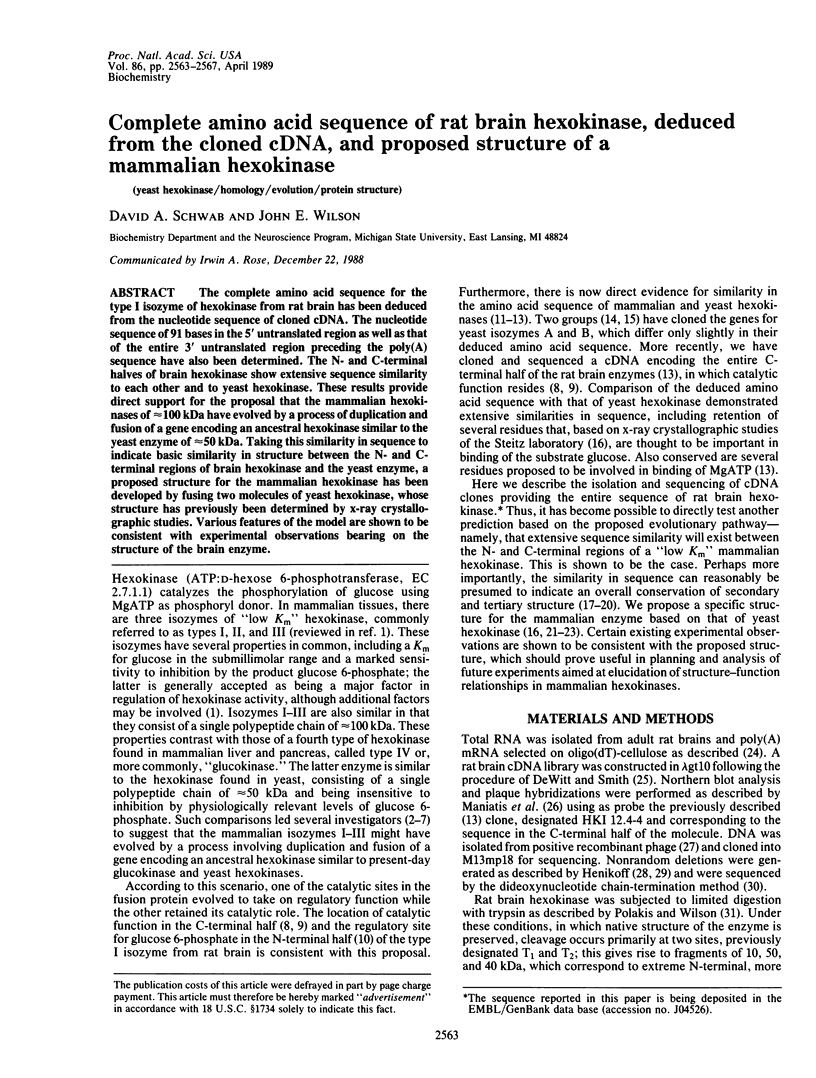
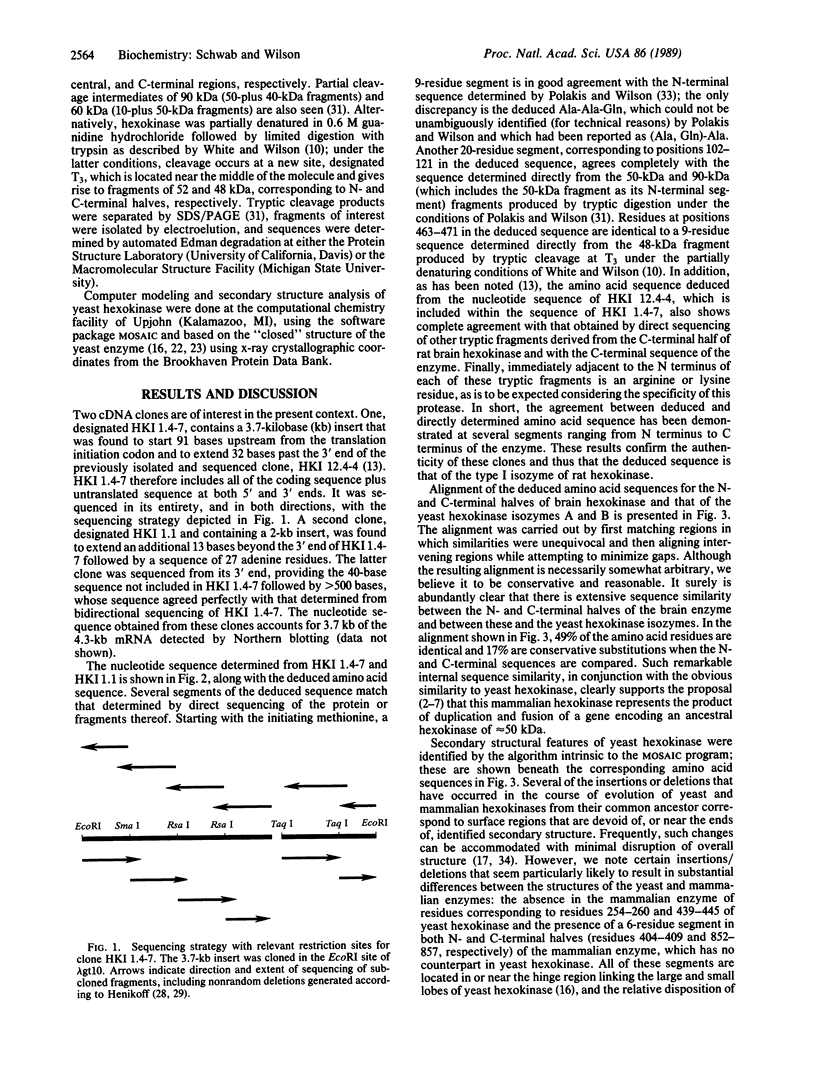
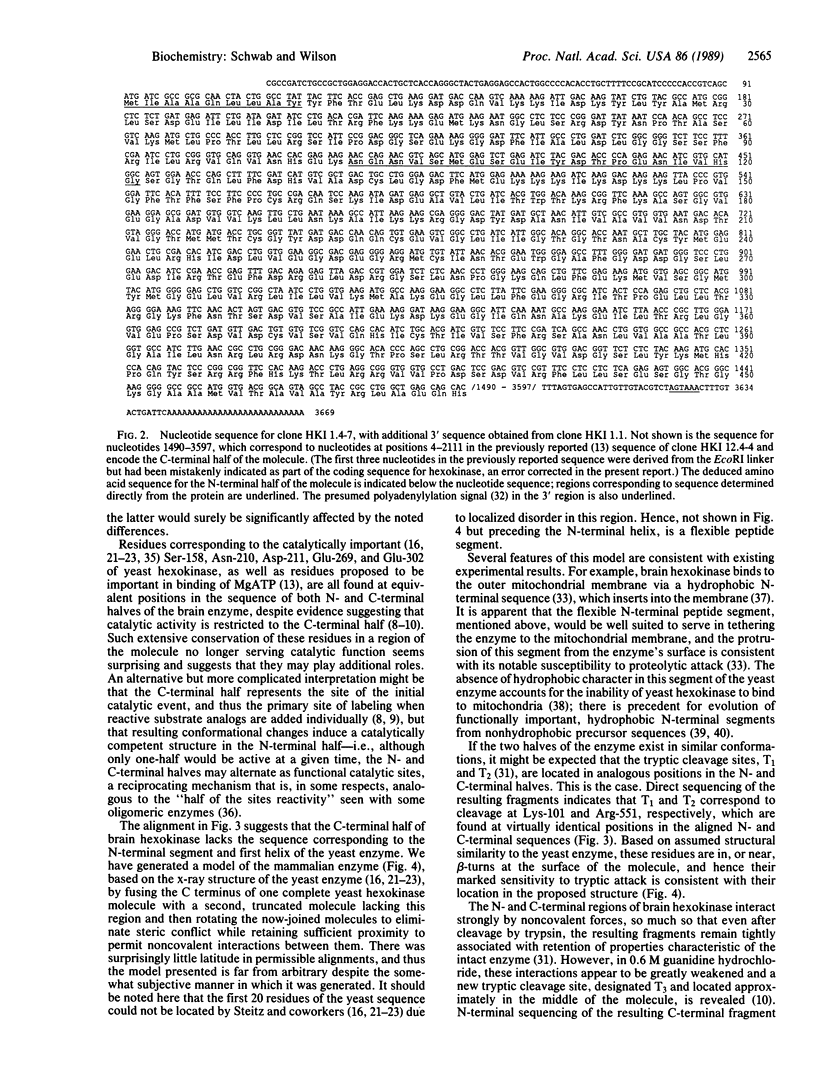
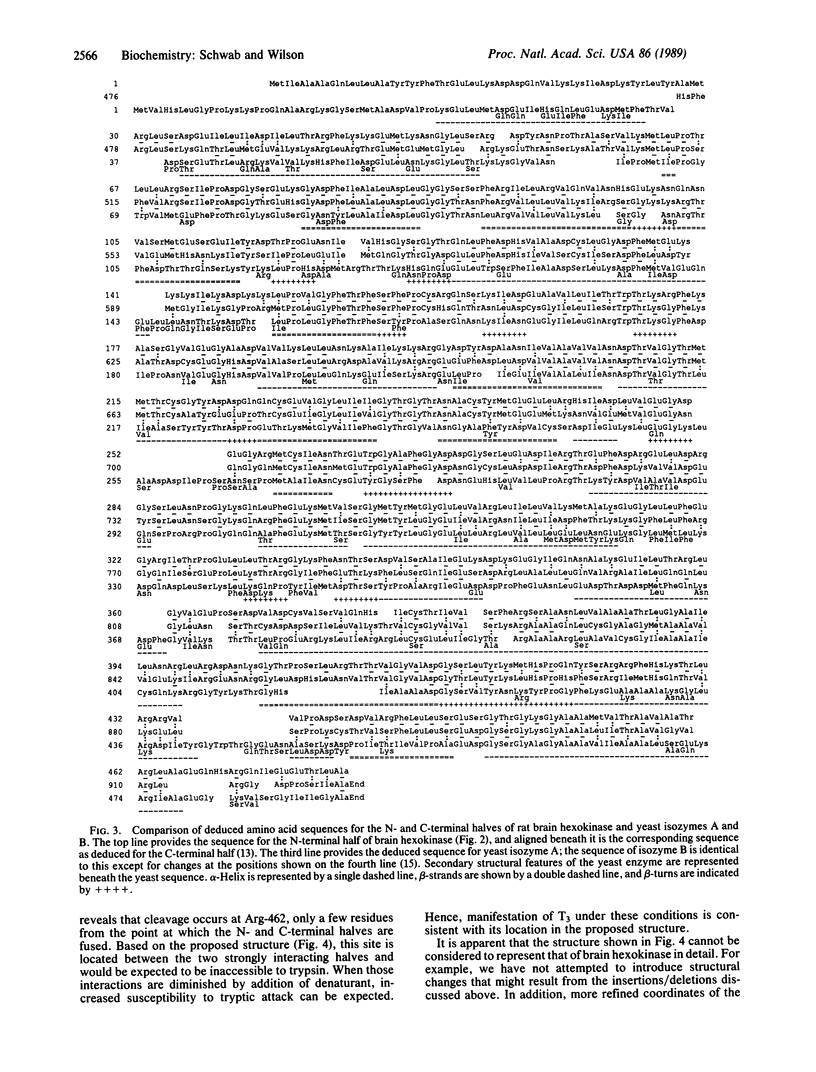
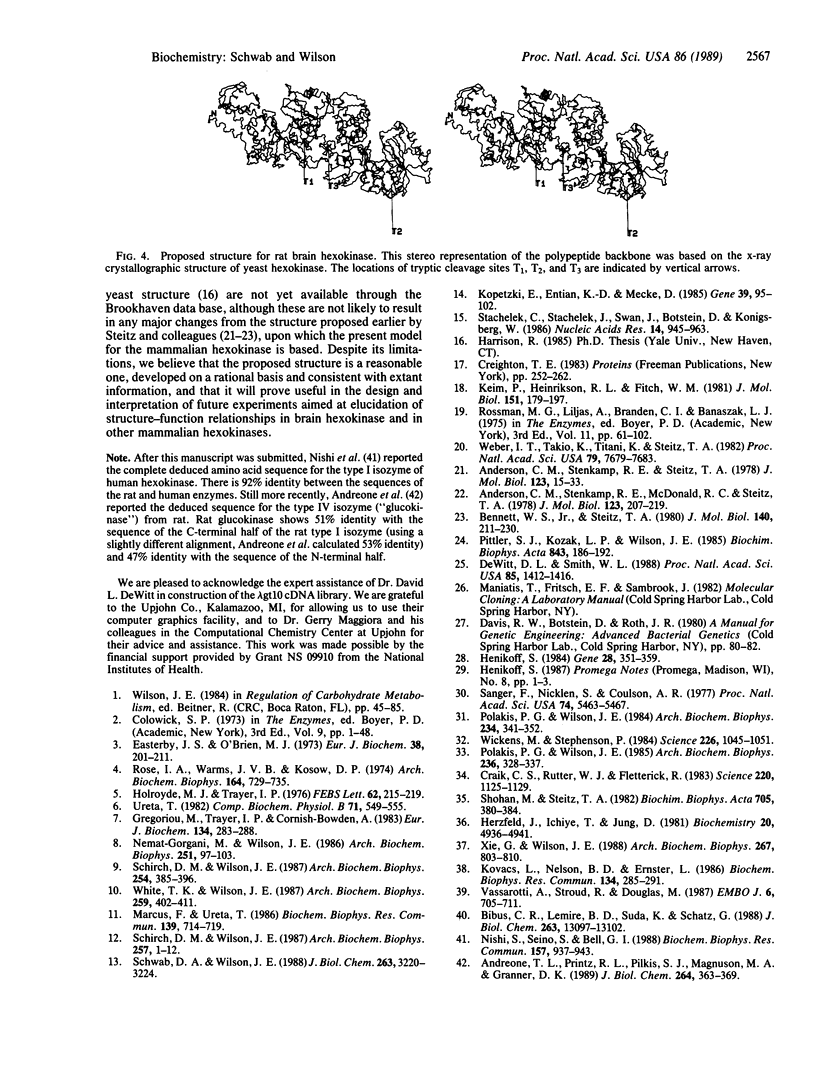
Selected References
These references are in PubMed. This may not be the complete list of references from this article.
- Anderson C. M., Stenkamp R. E., McDonald R. C., Steitz T. A. A refined model of the sugar binding site of yeast hexokinase B. J Mol Biol. 1978 Aug 5;123(2):207–219. doi: 10.1016/0022-2836(78)90321-2. [DOI] [PubMed] [Google Scholar]
- Anderson C. M., Stenkamp R. E., Steitz T. A. Sequencing a protein by x-ray crystallography. II. Refinement of yeast hexokinase B co-ordinates and sequence at 2.1 A resolution. J Mol Biol. 1978 Jul 25;123(1):15–33. doi: 10.1016/0022-2836(78)90374-1. [DOI] [PubMed] [Google Scholar]
- Andreone T. L., Printz R. L., Pilkis S. J., Magnuson M. A., Granner D. K. The amino acid sequence of rat liver glucokinase deduced from cloned cDNA. J Biol Chem. 1989 Jan 5;264(1):363–369. [PubMed] [Google Scholar]
- Bennett W. S., Jr, Steitz T. A. Structure of a complex between yeast hexokinase A and glucose. II. Detailed comparisons of conformation and active site configuration with the native hexokinase B monomer and dimer. J Mol Biol. 1980 Jun 25;140(2):211–230. doi: 10.1016/0022-2836(80)90103-5. [DOI] [PubMed] [Google Scholar]
- Bibus C. R., Lemire B. D., Suda K., Schatz G. Mutations restoring import of a yeast mitochondrial protein with a nonfunctional presequence. J Biol Chem. 1988 Sep 15;263(26):13097–13102. [PubMed] [Google Scholar]
- Craik C. S., Rutter W. J., Fletterick R. Splice junctions: association with variation in protein structure. Science. 1983 Jun 10;220(4602):1125–1129. doi: 10.1126/science.6344214. [DOI] [PubMed] [Google Scholar]
- DeWitt D. L., Smith W. L. Primary structure of prostaglandin G/H synthase from sheep vesicular gland determined from the complementary DNA sequence. Proc Natl Acad Sci U S A. 1988 Mar;85(5):1412–1416. doi: 10.1073/pnas.85.5.1412. [DOI] [PMC free article] [PubMed] [Google Scholar]
- Easterby J. S., O'Brien M. J. Purification and properties of pig-heart hexokinase. Eur J Biochem. 1973 Oct 5;38(2):201–211. doi: 10.1111/j.1432-1033.1973.tb03051.x. [DOI] [PubMed] [Google Scholar]
- Gregoriou M., Trayer I. P., Cornish-Bowden A. Isotope-exchange evidence that glucose 6-phosphate inhibits rat-muscle hexokinase II at an allosteric site. Eur J Biochem. 1983 Aug 1;134(2):283–288. doi: 10.1111/j.1432-1033.1983.tb07563.x. [DOI] [PubMed] [Google Scholar]
- Henikoff S. Unidirectional digestion with exonuclease III creates targeted breakpoints for DNA sequencing. Gene. 1984 Jun;28(3):351–359. doi: 10.1016/0378-1119(84)90153-7. [DOI] [PubMed] [Google Scholar]
- Herzfeld J., Ichiye T., Jung D. Molecular symmetry and metastable states of enzymes exhibiting half-of-the-sites reactivity. Biochemistry. 1981 Aug 18;20(17):4936–4941. doi: 10.1021/bi00520a020. [DOI] [PubMed] [Google Scholar]
- Holroyde M. J., Trayer I. P. Purification and properties of rat skeletal muscle hexokinase. FEBS Lett. 1976 Feb 15;62(2):215–219. doi: 10.1016/0014-5793(76)80056-7. [DOI] [PubMed] [Google Scholar]
- Keim P., Heinrikson R. L., Fitch W. M. An examination of the expected degree of sequence similarity that might arise in proteins that have converged to similar conformational states. The impact of such expectations on the search for homology between the structurally similar domains of rhodanese. J Mol Biol. 1981 Sep 5;151(1):179–197. doi: 10.1016/0022-2836(81)90227-8. [DOI] [PubMed] [Google Scholar]
- Kopetzki E., Entian K. D., Mecke D. Complete nucleotide sequence of the hexokinase PI gene (HXK1) of Saccharomyces cerevisiae. Gene. 1985;39(1):95–101. doi: 10.1016/0378-1119(85)90113-1. [DOI] [PubMed] [Google Scholar]
- Kovác L., Nelson B. D., Ernster L. A method for determining the intracellular distribution of enzymes in yeast provides no evidence for the association of hexokinase with mitochondria. Biochem Biophys Res Commun. 1986 Jan 14;134(1):285–291. doi: 10.1016/0006-291x(86)90560-7. [DOI] [PubMed] [Google Scholar]
- Marcus F., Ureta T. Amino acid sequence homology between yeast hexokinases and rat hexokinase C. Biochem Biophys Res Commun. 1986 Sep 14;139(2):714–719. doi: 10.1016/s0006-291x(86)80049-3. [DOI] [PubMed] [Google Scholar]
- Nemat-Gorgani M., Wilson J. E. Rat brain hexokinase: location of the substrate nucleotide binding site in a structural domain at the C-terminus of the enzyme. Arch Biochem Biophys. 1986 Nov 15;251(1):97–103. doi: 10.1016/0003-9861(86)90055-x. [DOI] [PubMed] [Google Scholar]
- Nishi S., Seino S., Bell G. I. Human hexokinase: sequences of amino- and carboxyl-terminal halves are homologous. Biochem Biophys Res Commun. 1988 Dec 30;157(3):937–943. doi: 10.1016/s0006-291x(88)80964-1. [DOI] [PubMed] [Google Scholar]
- Pittler S. J., Kozak L. P., Wilson J. E. In vitro synthesis of rat brain hexokinase. Biochim Biophys Acta. 1985 Dec 13;843(3):186–192. doi: 10.1016/0304-4165(85)90138-2. [DOI] [PubMed] [Google Scholar]
- Polakis P. G., Wilson J. E. An intact hydrophobic N-terminal sequence is critical for binding of rat brain hexokinase to mitochondria. Arch Biochem Biophys. 1985 Jan;236(1):328–337. doi: 10.1016/0003-9861(85)90633-2. [DOI] [PubMed] [Google Scholar]
- Polakis P. G., Wilson J. E. Proteolytic dissection of rat brain hexokinase: determination of the cleavage pattern during limited digestion with trypsin. Arch Biochem Biophys. 1984 Nov 1;234(2):341–352. doi: 10.1016/0003-9861(84)90279-0. [DOI] [PubMed] [Google Scholar]
- Rose I. A., Warms J. V., Kosow D. P. Specificity for the glucose-6-P inhibition site of hexokinase. Arch Biochem Biophys. 1974 Oct;164(2):729–735. doi: 10.1016/0003-9861(74)90086-1. [DOI] [PubMed] [Google Scholar]
- Sanger F., Nicklen S., Coulson A. R. DNA sequencing with chain-terminating inhibitors. Proc Natl Acad Sci U S A. 1977 Dec;74(12):5463–5467. doi: 10.1073/pnas.74.12.5463. [DOI] [PMC free article] [PubMed] [Google Scholar]
- Schirch D. M., Wilson J. E. Rat brain hexokinase: amino acid sequence at the substrate hexose binding site is homologous to that of yeast hexokinase. Arch Biochem Biophys. 1987 Aug 15;257(1):1–12. doi: 10.1016/0003-9861(87)90536-4. [DOI] [PubMed] [Google Scholar]
- Schirch D. M., Wilson J. E. Rat brain hexokinase: location of the substrate hexose binding site in a structural domain at the C-terminus of the enzyme. Arch Biochem Biophys. 1987 May 1;254(2):385–396. doi: 10.1016/0003-9861(87)90116-0. [DOI] [PubMed] [Google Scholar]
- Schwab D. A., Wilson J. E. The complete amino acid sequence of the catalytic domain of rat brain hexokinase, deduced from the cloned cDNA. J Biol Chem. 1988 Mar 5;263(7):3220–3224. [PubMed] [Google Scholar]
- Shoham M., Steitz T. A. The 6-hydroxymethyl group of a hexose is essential for the substrate-induced closure of the cleft in hexokinase. Biochim Biophys Acta. 1982 Aug 10;705(3):380–384. doi: 10.1016/0167-4838(82)90260-6. [DOI] [PubMed] [Google Scholar]
- Stachelek C., Stachelek J., Swan J., Botstein D., Konigsberg W. Identification, cloning and sequence determination of the genes specifying hexokinase A and B from yeast. Nucleic Acids Res. 1986 Jan 24;14(2):945–963. doi: 10.1093/nar/14.2.945. [DOI] [PMC free article] [PubMed] [Google Scholar]
- Ureta T. The comparative isozymology of vertebrate hexokinases. Comp Biochem Physiol B. 1982;71(4):549–555. doi: 10.1016/0305-0491(82)90461-8. [DOI] [PubMed] [Google Scholar]
- Vassarotti A., Stroud R., Douglas M. Independent mutations at the amino terminus of a protein act as surrogate signals for mitochondrial import. EMBO J. 1987 Mar;6(3):705–711. doi: 10.1002/j.1460-2075.1987.tb04811.x. [DOI] [PMC free article] [PubMed] [Google Scholar]
- Weber I. T., Takio K., Titani K., Steitz T. A. The cAMP-binding domains of the regulatory subunit of cAMP-dependent protein kinase and the catabolite gene activator protein are homologous. Proc Natl Acad Sci U S A. 1982 Dec;79(24):7679–7683. doi: 10.1073/pnas.79.24.7679. [DOI] [PMC free article] [PubMed] [Google Scholar]
- White T. K., Wilson J. E. Rat brain hexokinase: location of the allosteric regulatory site in a structural domain at the N-terminus of the enzyme. Arch Biochem Biophys. 1987 Dec;259(2):402–411. doi: 10.1016/0003-9861(87)90506-6. [DOI] [PubMed] [Google Scholar]
- Wickens M., Stephenson P. Role of the conserved AAUAAA sequence: four AAUAAA point mutants prevent messenger RNA 3' end formation. Science. 1984 Nov 30;226(4678):1045–1051. doi: 10.1126/science.6208611. [DOI] [PubMed] [Google Scholar]
- Xie G. C., Wilson J. E. Rat brain hexokinase: the hydrophobic N-terminus of the mitochondrially bound enzyme is inserted in the lipid bilayer. Arch Biochem Biophys. 1988 Dec;267(2):803–810. doi: 10.1016/0003-9861(88)90090-2. [DOI] [PubMed] [Google Scholar]


